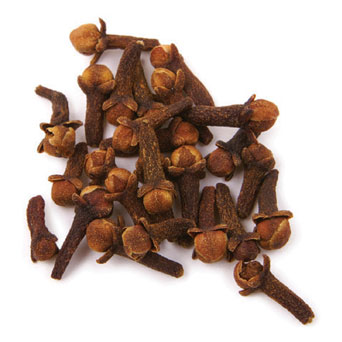Han X, Parker TL Pharmaceutical Biology, 2017 CONTEXT: Clove (Eugenia caryophyllata Thunb. [Myrtaceae]) essential oil (CEO) has been shown to possess antimicrobial, antifungal, antiviral, antioxidant, anti-inflammatory and anticancer properties. However, few studies have focused on its topical use. OBJECTIVE: We investigated the biological activity of a commercially available CEO in a human skin disease model…. Read more »

- Botanical Name: Eugenia caryophyllata
- Alternative Names: Clove bud
- Botanical Family: Myrtaceae
- Primary Constituent: Eugenol
- Other Main Constituents: Caryophyllene, Eugenol acetate
- Distillation Method: Steam Distillation
- Plant Part: Bud
Antitumor phenylpropanoids found in essential oils
Carvalho AA, Andrade LN, de Sousa ÉB, de Sousa DP Biomed Research International, 2015 ABSTRACT: The search for new bioactive substances with anticancer activity and the understanding of their mechanisms of action are high-priorities in the research effort toward more effective treatments for cancer. The phenylpropanoids are natural products found in many aromatic and medicinal… Read more »
Effects of clove essential oil and eugenol on quality and browning control of fresh-cut lettuce
Chen X, Ren L, Li M, Qian J, Fan J, Du B Food Chemistry, 2017 ABSTRACT: This study confirmed the inhibitory effects of clove essential oil (CEO) and eugenol (EUG) on the browning and relevant enzymes of fresh-cut lettuce, and examined associated mechanisms by inhibition kinetics and computational docking analysis. Fresh-cut lettuce was treated with… Read more »
Use of cloves and cinnamon essential oil to inactivate Listeria monocytogenes in ground beef at freezing and refrigeration temperatures
Khalequea MA, Keyaa CA, Hasana KN, Hoquec MM, Inatsud Y, Barib ML LWT – Food Science and Technology, 2016 ABSTRACT: The need for better control of foodborne pathogens has been of paramount importance in recent years as one of the major concerns to ensure food safety. This study was aimed to determine whether Cloves (Syzygium aromaticum)… Read more »
Effects of topical and systemic administration of Eugenia caryophyllata buds essential oil on corneal anesthesia and analgesia
Khalilzadeh E, Hazrati R, Saiah GV Research in pharmaceutical sciences, 2016 ABSTRACT: Clinical studies suggest that essential oil of Eugenia caryophyllata (Clove) buds (EOEC) is efficacious in the treatment of dental pain. In the present study, we investigated the analgesic and local anesthetic effects of EOEC and its possible mechanisms of action in acute corneal… Read more »
Biocidal activity of two essential oils on fungi that cause degradation of paper documents
Borrego S, Gomez De Saravia S, Valdes O, Vivar I, Battistoni P, Guiamet P International Journal of Conservation Science, 2016 ABSTRACT: The aim of this study was to evaluate the biocidal activity of essential oils of Syzygium aromaticum (L.) Merr. and L. M. Perry (nail) and Allium sativum L. (garlic) against different fungal species producing… Read more »
Plants traditionally used as mosquito repellents and the implication for their use in vector control
Tisgratog R, Sanguanpong U, Grieco JP, Ngoen-Kluan R, Chareonviriyaphap T Acta tropica, 2016 ABSTRACT: Numerous plants with insect repelling properties are native to the tropics where they are produced for a wide range of medicinal purposes. In Thailand, these native plant species have a history of use for personal protection against biting insects. From our… Read more »
Investigation of the dermal sensitization potential of various essential oils in the local lymph node assay
Lalko J, Api AM
Food and Chemical Toxicology: An International Journal Published for the British Industrial Biological Research Association, 2006
Effects of selected plant essential oils on the growth and development of mouse preimplantation embryos in vivo
Domaracký M, Rehák P, Juhás S, Koppel J
Physiological Research/Academia Scientiarum Bohemoslovaca, 2007
The additive properties of Oxygen Radical Absorbance Capacity (ORAC) assay: the case of essential oils
Bentayeb K, Vera P, Rubio C, Nerín C
Food Chemistry, 2014
